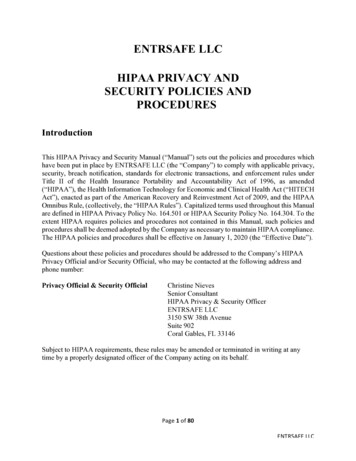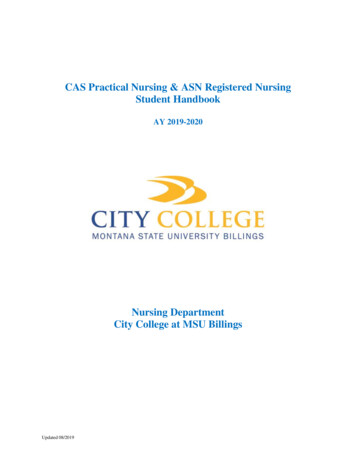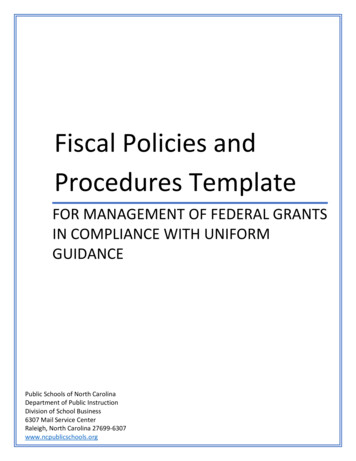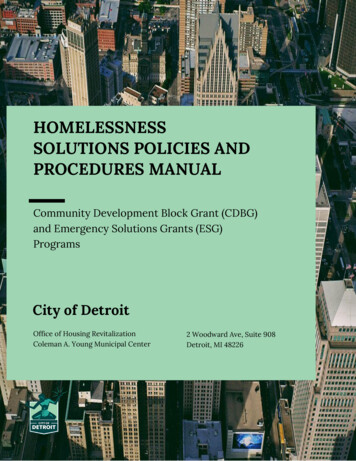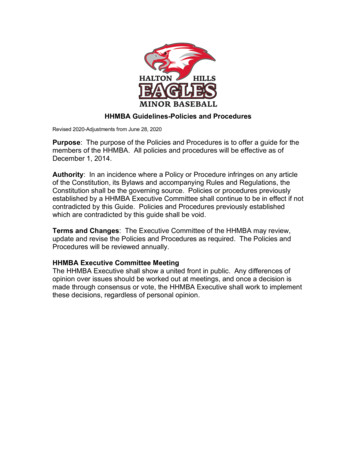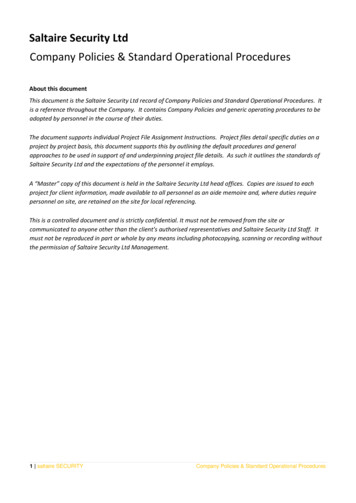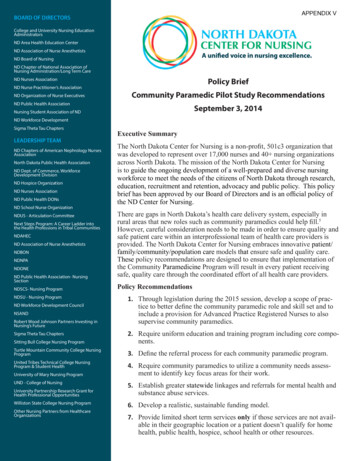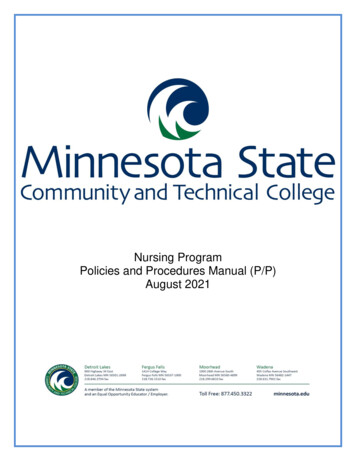
Transcription
Nursing ProgramPolicies and Procedures Manual (P/P)August 2021
(Page intentionally left blank)
WELCOME to the Minnesota State Community and Technical College (M State) Nursing Program!We are excited that you have chosen to pursue your nursing career with us. We are proud of ourhistory and excited about our future as we continue to excel in the area of nursing education. M Statefaculty and staff are here to support you as you pursue your nursing education.This M State Nursing Program Policies and Procedures Manual has been prepared to help youlearn about the structure and expectations of our nursing program. It also provides the framework forthe academic and clinical laboratory policies and requirements we have instituted in order to maintainan effective and efficient nursing program. The most up-to-date electronic version is always locatedon the Accepted Nursing Students web page.The M State Student College Handbook addresses the policies for all students enrolled in thecollege, including nursing students. Nursing students are to refer to the M State College StudentHandbook, located on the Student Handbook page of the M State College website, for all informationthat is not specific to the nursing program and contained in the Program Policies and ProceduresManual.Please take the time to read and familiarize yourself with the Nursing Program Policies andProcedures Manual, as well as the College Student Handbook. It is your responsibility to know thecontent of both.Again, I want to say welcome to Minnesota State Community and Technical College NursingProgram. We look forward to partnering with you throughout your educational journey.Warmest Regards,Dr. John Maduko M.DVice President of Academic & Student AffairsInterim Dean of Health Careersjohn.maduko@minnesota.edu1
(Page intentionally left blank)2
Table of ContentsNursing Policies and Procedures Manual (P/P) Information . 6Governing Bodies . 7Minnesota State Colleges and Universities Board . 7Controlling Body. 7Accreditation and Approval . 7Minnesota Board of Nursing . 7National Accreditation . 7Mission and Philosophy . 8M State’s Core Abilities . 10Nursing Options at M State. 10Associate Degree Nursing Program: Generic & Mobility Options . 11Program Student Learner Outcomes (PSLOs) for Associate Degree Nursing Program . 13Associate Degree Nursing ADN Course Descriptions . 14Practical Nursing: Diploma . 18Program Student Learner Outcomes (SLOs) for Practical Nursing Program . 20Practical Nursing Course Descriptions . 21Technical Standards for Entry-Level Nursing Programs . 23General Program Policies . 25CPR Certification . 25Nursing Assistant. 26Practical Nursing Licensure . 26Health Declaration Information . 26Minnesota Department of Health Background Study . 26National Background Study. 27Federal Background Study . 28Nursing Program Required Document Retention . 28Financial Aid, Academic, and Advising Records Retention . 28Liability Insurance . 28Health Insurance . 29Legal Documents and Student Credentials . 29Laptop Computer Requirements . 293
Reasonable Disability Accommodations . 29Diversity and Intercultural Services . 30Student Clubs and Activities . 30Other Student Support. 30Additional Costs . 30Nursing Academic Policies . 31Student Learner Outcomes . 31Attendance. 31Grading Policy . 32Client Categories . 32Dosage Calculation Competency . 32Assessment Technologies Institute (ATI) Integrated Learning System . 33Copyright Statement . 33Children in the Learning Environments . 33General Clinical, Laboratory, Simulation, and Community Service Policies . 33Uniforms . 33Jewelry & Body Art. 34Personal Hygiene . 34Unacceptable Attire for Clinical, Laboratory, Simulation, and/or Service Learning . 34General Lab Safety . 35High Hazard Exposure and Injury . 35Latex Exposure . 36Course Progression . 36General Progression Guidelines . 36Nursing Program Course Progression Guidelines . 382 yr. and LPN-- ADN Bridge Program (Associate Degree in Nursing - ADN) . 38Practical Nursing Program . 40Nursing Progression and Transfer Policy . 42Procedure for Submitting a Revised Plan of Study . 42Nursing Transfer and Progression Team Decisions. 43Nursing Appeals Policy and Procedure . 43Procedure for Submitting an Appeal . 444
Nursing Appeals Council Decisions . 45Official Student Grievances. 45Nursing Student Professional and Ethical Behavior Policies. 46Student Conduct . 46Professional Boundaries . 46Confidentiality . 46Academic Dishonesty and Integrity Misconduct . 46Plagiarism . 47Social Media . 47Professional Integrity . 48Nursing Program Probation . 49Probation Procedure . 49Probation Consequences . 50Gross Unsafe Practice . 50Graduation, NCLEX Examination, and Licensure. 51Graduation . 51NCLEX Examination and Licensure . 51Applying for the NCLEX Examination . 51Students Taking NCLEX and Seeking Licensure in Minnesota. 52Students Taking NCLEX and Seeking Licensure in North Dakota . 52Students Taking NCLEX and Seeking Licensure in States Other Than Minnesota or North Dakota . 52Appendix A: Nursing Program Framework . 53Appendix B: ADN and PN Program SLOs Comparison Table . 59Appendix C: Legal Definitions of Nursing (Scope of Practice). 60Appendix D: Nursing Code of Ethics. 62Appendix E: Social Media Policy . 63Appendix F: Program Probation Form . 64Appendix G: Health Declaration and Immunization Requirements . 65Appendix H: Certification of Medical Clearance . 66Appendix I: Glossary. 68Signature Sheet (Required Every Semester) . 71COVID-19 Addendum AY21-22 . 725
Nursing Policies and Procedures Manual (P/P) InformationThe Nursing Policies and Procedures Manual (also referred to as P/P) is intended to provide theinformation necessary for you to be successful in the M State Nursing Program. It is a guide for thestudent when concerns or questions arise during the program.The M State Nursing Program adheres to the policies and procedures outlined in this manual. Thepurpose of the online manual is to provide students, advisors, counselors, the public, faculty, andcollege administration a convenient, paperless vehicle for viewing up-to-date information about the MState Nursing Program options and associated courses, as well as other policies and proceduresassociated with the program. It is important for all online P/P Manual users to understand that thispublication is not intended to create any guarantees about current practices or program/courseofferings and does not constitute a contract between the student and the college or the nursingprogram.The manual may undergo changes following students’ admission and during their progression.Students are held to the standards outlined in the most current version uploaded to the M StateNursing webpage under the Accepted Nursing Students link. The M State Nursing Program iscommitted to communicating in a timely and accurate manner, therefore, students will be notifiedverbally and via email of changes when they occur. It is the user’s responsibility to seek clarificationand/or assistance from nursing faculty regarding any content questions. The most current publicationof this online manual supersedes all prior print or online publications.If you use a TTY, you can call us using the Minnesota Relay Service at 651.297.5353 or800.627.3529 and ask them to place a call to Minnesota State Community and Technical College.Upon request, this information will be made available in alternate formats. Minnesota StateCommunity and Technical College is an affirmative action, equal opportunity employer and educator.6
Governing BodiesMinnesota State Colleges and Universities BoardThe Minnesota State Colleges and Universities (Minnesota State) system is one of two systems ofpublic higher education in the state of Minnesota (the other is the University of Minnesota). TheMinnesota State system is 37 institutions with 54 campuses conveniently located in 47 Minnesotacommunities. We serve 375,000 students each year, with more Students of Color and AmericanIndian Students attending our colleges and universities than all other higher education providers inMinnesota combined. Minnesota State offers the lowest tuition in Minnesota, with 55.1% of ourcollege students and 61.3% of our university students receiving financial aid. The law creating thesystem was passed by the Minnesota Legislature in 1991 and went into effect July 1, 1995. The lawmerged the state's community colleges, technical colleges, and state universities into one system.Controlling BodyA controlling regulatory body, in the context of higher education, is an organization that has beenempowered by legislation to oversee and control the education process and outputs germane to it.Minnesota State is the ultimate controlling body of Minnesota State Community and TechnicalCollege (M State). M State is the official controlling body of the Nursing Program. M State policiesand procedures are determined through established college procedures.Accreditation and ApprovalMinnesota State Community and Technical College is accredited by the Higher LearningCommission; Member of the North Central Association (NCA). Information about NCA can be foundon their website at: http://www.ncahigherlearningcommission.org/ or you can write to them at 30North LaSalle Street, Suite 2400; Chicago, IL 50502-2504; telephone 312.263.0456.Minnesota Board of NursingThe Practical and Professional Nursing Programs are approved by the Minnesota Board of Nursing.The Minnesota Board of Nursing can be contacted at the following address:Minnesota Board of Nursing1210 Northland Drive Suite 120Mendota Heights, MN 55120(612) 317-3000E-mail: sing/National AccreditationThe Minnesota State Community Technical College Associate Degree in Nursing and PracticalNursing programs are accredited system-wide by the National League for Nursing Commission forNursing Education Accreditation (NLN CNEA) 2600 Virginia Avenue, NW, Washington, DC 20032,202-909-2526.7
Mission and PhilosophyM State Mission: Minnesota State Community and Technical College specializes in affordable andexceptional education, service, and workforce training. We welcome all students and engage them inshaping their futures and their communities.M State Vision: A success story for every student.M State Values: Integrity: As dedicated professionals, we act with purpose in everything we do. We are sincere andhonest in our relationships and communications, and hold ourselves accountable to doing the right thingeven when no one is watching.Inclusion: We welcome, respect and accept people for who they are and celebrate the power of ourcollective differences in creating and shaping more robust, energized communities.Innovation: Through the power of our four campuses, strategic partnerships and creative problemsolving, we enhance communities. We incorporate technology to improve the student experience, andwe see continuous improvement as a constant.M State Nursing Mission: Preparing practical and associate degree nursing students for licensureby providing dynamic learning, while fostering scholarship and excellence in nursing to contribute tothe health of the community and create a positive impact to healthcare.M State Nursing Philosophy: The Minnesota State Community and Technical College (M State)Nursing Program is grounded in the biological, psychological, sociological, and spiritual sciences. Thenursing faculty of M State regard nursing as a noble profession and embrace the core values ofcaring, integrity, diversity, excellence, ethics, patient centeredness, and holism as we aim to integrateand model the core values in all we say, do, and teach. We believe that nursing students graduatingfrom the M State Nursing Program must be ready to practice in a complex and changing healthcareenvironment.M State nursing faculty support an environment that is conducive to learning and working while beingresponsive to the communities that we serve. M State nursing faculty prepare students to becomepractical and professional nurses in an educational environment that promotes critical thinking,growth of the individual student, and a holistic view of healthcare. Faculty recognize the diverselearning needs and strengths of the nursing student and utilize a variety of learning strategies topromote learning. The student is expected to be caring, conscientious, flexible, professional, andaccountable for their actions. We utilize the classroom, simulation, and clinical experiences to providea variety of learning opportunities for students.Promotion of a culture of caring is a fundamental part of the nursing profession and is characterizedby the nurse’s concern and consideration of the whole person. M State nursing faculty interweavecaring concepts throughout the nursing program in all organizational activities that are managed in aparticipative and patient-centered way. Demonstrating caring abilities by considering the needs of thepatient, family, and community utilizing the nursing process is integral to the success of the nursingstudent.M State nursing faculty promote a culture of integrity by respecting the dignity and moral wholenessof every person without conditions or limitations. We believe promoting integrity is necessary to8
nurture professional identity as well as promote quality and safety in nursing. Integrity is evident whenorganizational principles of open communication, ethical decision-making, and humility areencouraged, expected, and demonstrated consistently. The nursing faculty believe that doing theright thing is not only how one should do business, but how one’s actions reveal commitment to truthtelling. The M State nursing faculty support and integrate the M State college wide policy of AcademicHonesty and Integrity.M State nursing faculty recognize uniqueness and embrace diversity for all individuals. By promotingmutual acceptance and respect, teamwork and collaboration are incorporated into our curriculum. MState nursing faculty prioritize teaching and learning not only of students, but also of patients andfamilies in a culturally diverse setting across the age continuum. We believe that patient-centeredcare is best achieved by encompassing diversity throughout the curriculum.Excellence is requiring exceptional standards for oneself and all nursing and inter-professional teamswhile also demanding adherence to those high standards, despite opposition. Excellence is notaccepting anything less than the absolute best (Grossman & Valiga, 2013). Supporting a culture ofexcellence, M State nursing faculty encourage teamwork and collaboration as well as effective opencommunication to promote safe quality patient-centered care. M State faculty partake in andencourage professionalism and a commitment to lifelong learning in nursing through continuousprofessional development. Our commitment to excellence embraces evidenced-based practice andchange that is innovative and transformational.Ethics in nursing practice is shaped by personal, societal and professional values. M State nursingfaculty require the application of ethical principles while caring for patients, families and communities.These ethical principles are promoted as part of human caring while respecting the dignity, selfdetermination, and worth of all persons. Ethical enculturation is evidenced by the inclusion of ethicsthroughout nursing curriculum, promoted in the classroom environment where a spirit of inquiry isencouraged, and is communicated through student interactions as they provide patient-centered care.Holism is an integral part of human flourishing that affirms the synergy, attributes, values, andbehaviors of the individual. M State faculty believe in exemplifying patient-centered care throughteamwork and collaboration with the patient and family. Respect for personal experiences, culturalvalues, religious beliefs and practices, moral and ethical constructs, societal norms, physicalcharacteristics, and patient autonomy nourish the spirit of inquiry as students implement care ofpatients within the context of the wellness-illness continuum.Patient-centeredness is the primary focus of care that incorporates and reflects the uniqueness of anindividual patient’s background, personal preferences, culture, values, traditions, and family. M Statefaculty believe in exemplifying a patient-centered approach that supports respectful, efficient, safe,and well-coordinated transition of the patient through all levels of care.ReferenceGrossman, S., & Valiga, T. (2013). The new leadership challenge: Creating the future of nursing (4th ed.). Philadelphia, PA: F. A. Davis.9
M State’s Core AbilitiesThe college has identified the following as core abilities that all M State graduates, earning associatedegrees and diplomas, will achieve through their program of study.Demonstrate effective communicationIndicators1. Learner writes clearly, concisely, and accurately in appropriate context and format.2. Learner speaks clearly, concisely, and accurately in a variety of context and formats.3. Learner comprehends written and verbal communication.Demonstrate critical thinkingIndicators1. Learner draws conclusions based on evidence.2. Learner distinguishes between facts, fallacies, inferences and judgments.3. Learner considers multiple perspectives in problem solving.Demonstrate quantitative and logical reasoningIndicators1. Learner performs computations using appropriate methods.2. Learner demonstrates numerical and logical reasoning.Demonstrate personal and social responsibilityIndicators1.2.3.4.5.Learner demonstrates personal integrity and professional ethical practices.Learner demonstrates respect for the rights, views an
The nursing faculty of M State regard nursing as a noble profession and embrace the core values of caring, integrity, diversity, excellence, ethics, patient centeredness, and holism as we aim to integrate and model the core values in all we say, do, and teach.
